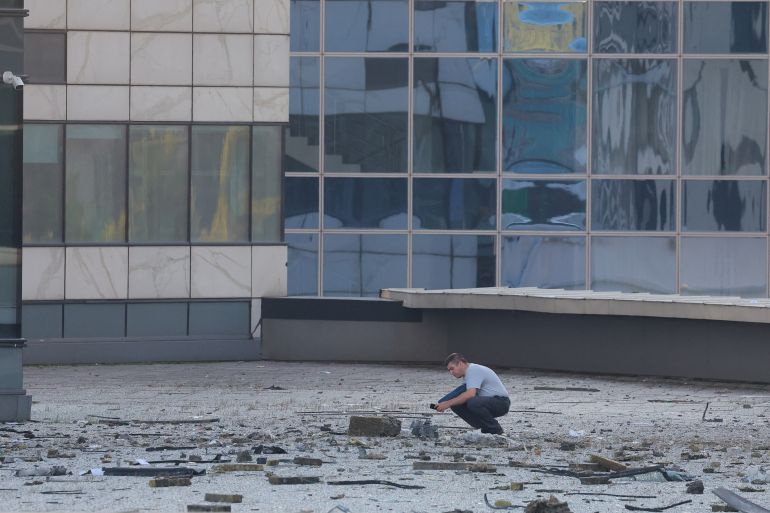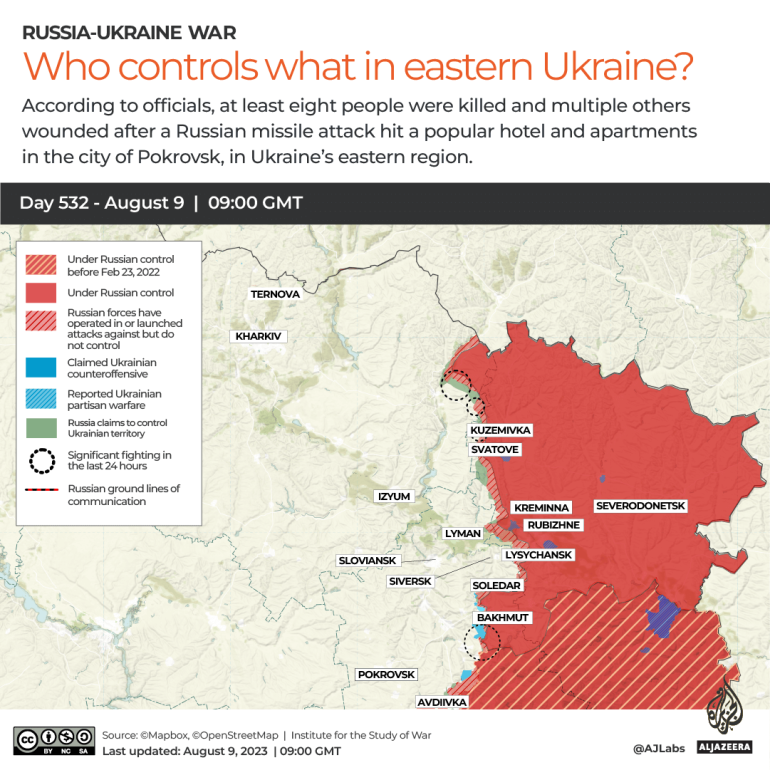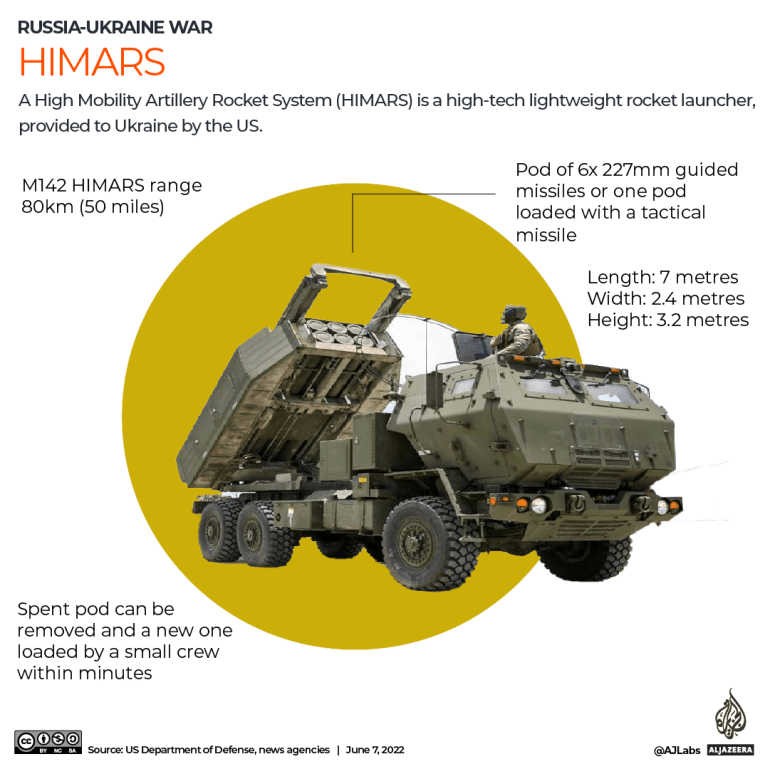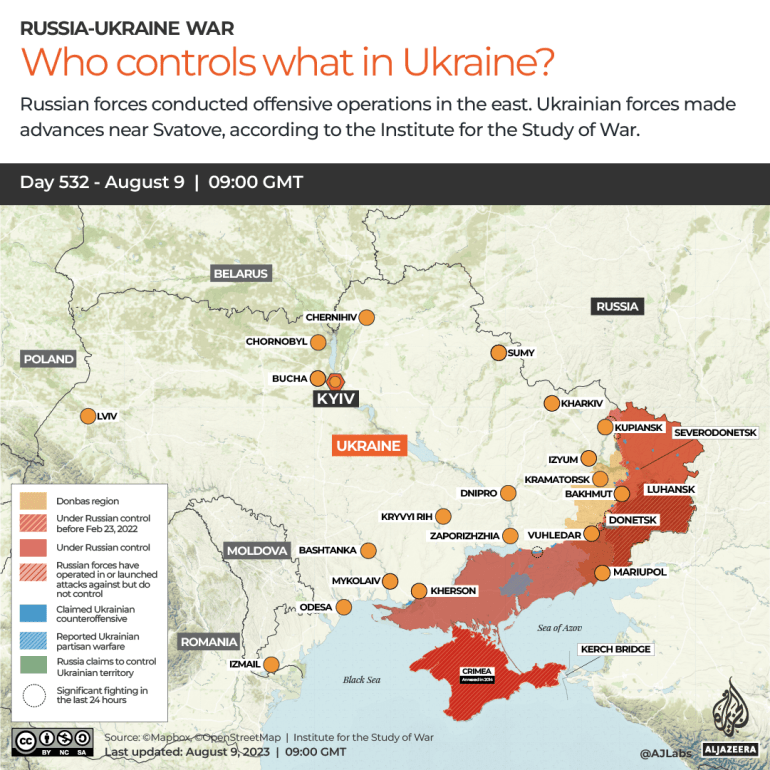Russia faces ‘great dilemma’ as Ukraine puts Moscow on the defensive
What happened in the 76th week of Russia’s war in Ukraine?

Bogged down in small-scale infantry attacks and incremental advances, Ukraine sought to gain an advantage in the 76th week of the war by attacking Russian shipping at range and was accused of drone strikes targeting Moscow.
Drone footage Ukraine released on August 4 showed the prow of a surface drone approaching the Olenegorsky Gornyak, a Ropucha-class Russian landing ship, before going blank at contact range.
Keep reading
list of 4 itemsRussia-Ukraine war updates: Kyiv says ‘difficult to hold ground’
US promises Ukraine military aid to make ‘real difference’ on the way
Russia-Ukraine war: List of key events, day 810
The attack happened just outside Novorossiysk harbour, supposedly a safe port on the eastern edge of the Black Sea, to which Russia had relocated much of its navy fleet based in Sevastopol after Ukraine sank its Black Sea flagship in May.
Daylight footage showed the Olenegorsky Gornyak listing severely to port as it was towed to Novorossiysk harbour.
“This poses a great dilemma for the Russians,” wrote Phillips O’Brien, professor of strategy at St Andrews University.
“Do they now deploy more of their surface assets to protect tankers and the like while they transit the Black Sea – which will make those warships inviting targets? Do they try to attack the Ukrainian coast – which has already shown itself to be deadly to Russian forces?”
Russia’s Ministry of Defence said it destroyed two other surface drones near Novorossiysk on the same night.
Russian sources claimed a single compartment had been flooded and would be quickly repaired, but British military intelligence said the 30-40 degree list “suggests that several watertight compartments were breached”.
Ukrainian military intelligence spokesperson Andriy Yusov said the damage was “very significant” and repairs would keep it out of action for a long time.

Another Ukrainian surface drone struck a Russian fuel tanker the following night, damaging it severely.
Russian news aggregator Baza said the drone flooded the tanker’s engine room.
The Moscow Times identified it as the SIG, under sanctions for ferrying jet fuel to Russian forces in Syria.
Reporters said the strike happened 27km (17 miles) south of the Kerch Bridge, which Ukraine has attacked twice before. These attacks on military and commercial shipping close to Russian mainland ports seem likely to continue. The State Hydrographic Service of Ukraine posted an open-ended notice to mariners announcing a “military threat” to a string of Russian Black Sea ports from the Kerch Strait to Sochi.
“Previous Ukrainian interdiction efforts have mainly focused on Russian military targets on land, but it seems that Ukrainian forces are now expanding their efforts to include naval targets as part of these efforts,” wrote the Washington, DC-based Institute for the Study of War, a think tank.
The Institute for the Study of War (ISW) likened these strikes to those that preceded a successful counteroffensive in Kharkiv and Kherson in September last year, saying Ukraine was “now striking much deeper into Russian rear areas and incorporating maritime targets”.
Logistics strikes and Russian retaliation
Ukraine continued its longstanding strategy of striking Russia’s supply lines in its deep rear.
For example, Ukraine used HIMARS to strike 200 Russian soldiers exposed on a Crimean beach on August 1, continuing to be vigilant for long-range possibilities of taking out Russian equipment and personnel wherever the opportunity arose
Geolocated footage on August 4 showed Ukrainian drones hitting close to an oil depot in Feodosia, on the Crimean Peninsula. Russia claimed to have destroyed or intercepted all 13 Ukrainian drones.
Two days later, Ukraine succeeded in severely damaging a bridge across the Henichesk Strait, connecting parts of Crimea to the mainland. And for a second time in as many weeks, Ukraine struck the nearby Chonhar Bridge, another critical supply chokepoint further south.

Southern forces’ spokesperson Natalia Humenyuk said the strikes forced Russia to reroute supplies and troops through the western side of the Crimean Peninsula, making their movement more predictable and vulnerable to a strike.
Russia responded with one of its largest salvoes of missiles against Ukraine in retaliation. Ukraine’s general staff said their forces shot down all 27 Shahed drones, 17 out of 20 Kalibr ship-launched cruise missiles and 13 out of 23 Kh-101/555 air-launched cruise missiles.
Ukrainian air force spokesperson Yuriy Ignat said the missiles were aimed at the Starokostyantyniv airfield, where Storm Shadow cruise missiles supplied by Britain and France are reported to be stored and launched.
Ignat said Ukraine has shot down some 1,200 Russian cruise missiles during the war, and Ukrainian President Volodymyr Zelenskyy said it has shot down more than 2,000 Russian drones.
Eastern and southern fronts
Ukrainian Deputy Defence Minister Hanna Maliar said Ukraine’s southern forces had broken through Russia’s first line of defence “in some places” and were fighting against the intermediate line.
But the only specifics offered during the week suggested meagre gains. Col Mykola Urshalovych said Ukrainian forces advanced up to 650 metres (2,133 feet) into Russian defences along a 1.5km (0.93-mile) front in the Melitopol direction on August 3.
The commander of Ukraine’s support forces, Brig-Gen Dmytro Gerega, said slow progress on the southern front was due to minefields, trenches, anti-tank concrete pyramids and barbed wire put up by Russian defenders. These defences were created in “strips” 10-40km (6-25 miles) long, he said, adding that Ukraine needed more de-mining equipment and additional trained personnel.

Ukraine’s military intelligence chief, Kyrylo Budanov, said Russian forces had built “stationary, fully-equipped, concrete-filled defence posts” in the south, and that most progress was in the east.
“Over time, the Ukrainians have been securing the advantage,” wrote Jack Watling, a defence expert at Royal United Services Institute, in a Financial Times opinion piece. “The question now is whether they can push Russian forces to breaking point.”
Ukrainian forces were advancing slowly to reduce losses, Watling said, but were eroding Russian artillery by provoking it to fire, pinpointing it and destroying it. He called this a “turning point”, allowing Ukrainian troops to take Russian positions.
Saudi summit
Ukraine also pressed ahead with a diplomatic initiative to win international support and erode tolerance for Russia’s war.
Ukraine has enjoyed the unstinting support of NATO, Japan, South Korea and Australia. On August 6, diplomats from 42 countries, including China and India, nominally supporters of Russia, joined a 42-nation summit in Riyadh, the Saudi capital, to call on Russia to respect the principles of international law, including respect for Ukrainian sovereignty and territorial integrity.
The communique was a slap in the face of Vladimir Putin, who days earlier staged a summit with African leaders in St Petersburg, attempting to put momentum behind his own quest to boost Russian grain and fertiliser exports.
The initiative suggested sanctions were biting into Russia’s economy. Reuters news agency reported that Russia had doubled its defence spending to $100bn this year, representing a third of the budget.